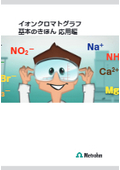Trace analysis of haloacetic acids, dalapon, and bromate in drinking water [Technical Document]
Trace analysis of carcinogenic substances such as haloacetic acids (HAA), dalapon, and bromate using ion chromatography.
We conducted the analysis by connecting the Metrohm ion chromatography (IC) to an Agilent triple quadrupole mass spectrometer (MS). This high-sensitivity method does not require sample extraction and can eliminate interferences from the eluent due to the Metrohm suppressor module. The matrix spike recovery rate for all target analytes at 1 μg/L was between 65% and 115%, and good results were obtained even with highly contaminated water samples.
basic information
The U.S. Environmental Protection Agency (EPA) and the EU have set the maximum allowable contaminant level for the total concentration of five haloacetic acids (HAA5: monochloroacetic acid (MCAA), monobromoacetic acid (MBAA), dichloroacetic acid (DCAA), dibromoacetic acid (DBAA), trichloroacetic acid (TCAA)) at 60 ppb (60 μg/L). EPA Method 557 describes a method for quantifying these compounds at the μg/L level in various types of water.
Price range
Delivery Time
Model number/Brand name
Ion chromatography
Applications/Examples of results
Trace analysis of haloacetic acids, dalapon, and bromate in drinking water by ion chromatography.
Detailed information
Related Videos
catalog(28)
Download All Catalogs















Recommended products
Distributors
Metrom AG, based in Herisau, Switzerland, is a leading company specializing in ion analysis with over 70 years of history. It provides products and services in more than 140 countries worldwide. Based on Swiss technology developed over many years, the equipment comes with a 3-year warranty.
































































